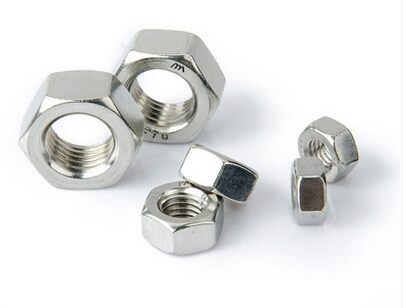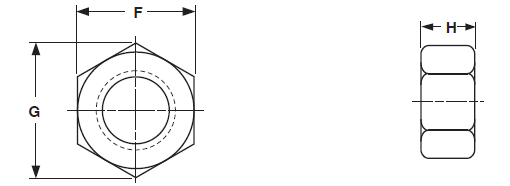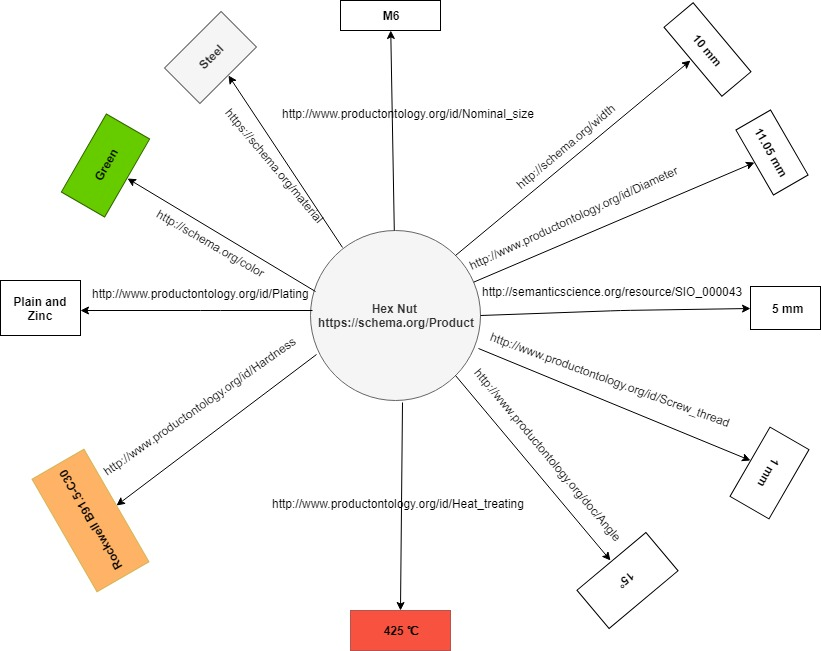Ferramentas de Utilizador
Tabela de Conteúdos
Universidade do Minho
Ph.D. Programme in Advanced Engineering Systems for Industry
Course of Information, Visualization, and Advanced CAD Systems (IVACS)
Hexagonal Nut’s Report
October 2018
Authors: Sahar Azadi (ID7526); Paulo Santos (ID7524)
1. Introduction
Nowadays, with the evolution of CAD systems, most engineers and people could design their own products but one of the issue in working with this program is they are proprietary and closed-coded, and also each of them having its own way of organizing the data. Therefore, arises the need to organize the data (data that has all the necessary information for the construction of any material object) in way that is open and can be interpreted in the same way throughout the world is necessary. Consequently, in this context, linked open data appears which is a new way allows to catalog several products that have the same property, with the same label through a link that points to a description of this property and also how to interpret the values saved together with the link. Also, let companies and individuals get more freedom in choosing proprietary software, because with this new catalog mode it’s possible to export our data from CAD systems to a file that can be interpreted by other CAD systems or software tools. In the past, without linked open data, companies had a harder time getting their own data from proprietary software and exporting it to new ones from different proprietary. This report presented the way of working with open linked data for one chosen product, a Hexagonal Nut, and describe different part of product with RDF. The report includes the introduction as a first part, in fallowing it will be briefly description about the Hexagonal Nut and presents the table showing each attributes of the product after that the graph of product is indicated in chapter 3. The last section will be the conclusion of this report.
2. Product
The Nut is a part that most of the objects have in, particular those containing mechanical parts. It consists of a single piece made from a single material type, and has the hexagonal shape. Inside has a thread to tighten a bolt. And it has several properties like: the material it is made of, the color of the paint that covers the part, the plating to modify the chemical properties of the surface, the heat treatment in the case of steel, the hardness of the material used, the diameter that is the largest dimension of the hexagon between two opposite vertexes, the width that is the dimension between two parallel sides of the hexagon, the thread, the thickness, and nominal size. All these attributes with their RDF link are shown in Table 1. In this table we present not only the link of properties but also the link of the Wikidata and also the short description of each attributes. Some attributes do not have any unit of measurement so we put the line to show that. On the other hand, we put the rang of the acceptable value for other attributes like diameter. Figure 1 displays the draw of Hex Nut which some attributes are more clear in that for example the thickness which shows with H, the diameter is G and the width is F.
Figure 1 - The drawing of Hex Nut
Table 1 - Attributes' of Hex Nut and The Links
| Metric-Hexagonal Nut (Hex Nut): https://schema.org/Product | |||||
| Attribute | Property URL | Wikidata | Description | Unit of Measurement | Acceptable Value |
| Material | https://schema.org/material | https://www.wikidata.org/wiki/Q214609 | Substance that can occur in different amounts, all with some similar [mixture of some] characteristics, and of which objects can be made up | Steel | |
| Color | http://schema.org/color | https://www.wikidata.org/wiki/Property:P462 | Color of subject | Steel, Red, Green, Blue, Black | |
| Diameter | http://www.productontology.org/id/Diameter | https://www.wikidata.org/wiki/Property:P2386 | The diameter of a circular or spherical object | Mm (Millimeter) | [4…30] |
| Thickness | http://semanticscience.org/resource/SIO_000043 | https://www.wikidata.org/wiki/Property:P2610 | Extent from one surface to the opposite | Mm (Millimeter) | [1.6…16] |
| Width | http://schema.org/width | https://www.wikidata.org/wiki/Property:P2049 | Width of an object | Mm (Millimeter) | [3.8…29.1] |
| Plating | http://www.productontology.org/id/Plating | www.wikidata.org/wiki/Q1193988 | Surface covering in which a metal is deposited on a conductive surface | ||
| Screw thread | http://www.productontology.org/id/Screw_thread | https://www.wikidata.org/wiki/Q389798 | Metric thread | Mm (Millimeter) | [0.4…2.5] |
| Hardness | http://www.productontology.org/id/Hardness | https://www.wikidata.org/wiki/Q3236003 | Measure of how resistant solid matter is to various kinds of permanent shape change when a force is applied | Rockwell (Scales B and C) | Scale B [78.7…91.5] Scale C [18…36] |
| Heat treatment | http://www.productontology.org/id/Heat_treating | https://www.wikidata.org/wiki/Q6774243 | A heat treatment for steel | Centigrade | 425 ℃ |
| Angle | http://www.productontology.org/doc/Angle | https://www.wikidata.org/wiki/Property:P4183 | Angle the principal axis of an item makes with the vertical; use degree (Q28390) as unit | Degree | [15°… 30°] |
| Nominal size | http://www.productontology.org/id/Nominal_size | https://www.wikidata.org/wiki/Q7048587 | In manufacturing, a nominal size or trade size is a size “in name only” used for identification | [M2…M20] | |
3. Graph
In this chapter, the developed graph for product is presented. As the product is simple all attributes are in one graph. Also the maximum of all attributes except the angle are chosen for Metric Hexagonal Nut M6, which means the nominal size of Nut is 6 (Figure 2). The minimum degree of angle is chosen because the shape of nut be more rectangular than to be round.
Figure 2 - The graph of Hex Nut M6 with the links of properties
4. Conclusion
With this work, we have seen the importance of web semantic each object in a way that any person, or anything (in the case of machines), and anywhere in the world can understand the type of data and its meaning. The most important subject is having the complete of our data and export it from one proprietary software to another, even if that software is closed source.







